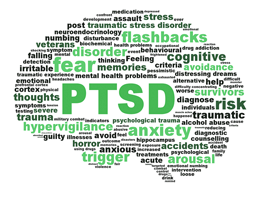Post-Traumatic Stress Disorder
PTSD and the DSM-5, Part 1
A conversation with Dr. Matt Friedman
Posted December 2, 2015
More than thirty-five years after the 1980 recognition of PTSD in the Diagnostic and Statistical Manual of Mental Disorders (DSM), the data are unequivocal: Today there can be no doubt about the validity of PTSD as a diagnostic entity. Yet, the disorder remains steeped in controversy, and more recently, there have been growing complaints that PTSD is being overemphasized in our society and over diagnosed in our hospitals.
PTSD can be found in its current avatar in the 2013 version of the DSM, called the DSM-5. Dr. Friedman is founder and former Executive Director of the National Center for Posttraumatic Stress Disorder and Professor of Psychiatry and of Pharmacology and Toxicology at the Geisel School of Medicine at Dartmouth. He was a member of the American Psychiatric Association’s (APA) DSM-5 Anxiety Disorders Work Group and chair of the Trauma and Dissociative Disorders Sub-Work Group.
Recently, I asked him about his work for the DSM-5 sub-work group.
Dr. Jain: The first question that I had was about the DSM-5 work group. The reason I ask about this is because I think, for a lay audience or scientists outside of our field, they may not be familiar with how much work went into the DSM-5. I was hoping you could speak a little bit about what that entailed, the scope of that mission, and the timeline of that whole effort.
Dr. Friedman: Basically, the DSM-5 had a work group for each diagnostic cluster. In the DSM-4, PTSD was an anxiety disorder, and the anxiety disorder group is the largest group of diagnoses. There were initially about a dozen of us who were asked to work on the anxiety disorder diagnoses. These were not just Americans, we had Europeans and people from Asia and other continents working with us.
When we looked at all these different anxiety disorder diagnoses, everything from panic disorder to obsessive compulsive disorder, and from tick disorders to PTSD, we felt that there was such a broad swath of diagnoses, and frankly, many of these diagnoses did not seem to belong together. So we divided ourselves into three work groups. There was the anxiety disorder work group, which looked at “classic” anxiety disorders (i.e., panic disorders, social anxiety, generalized anxiety disorder, agoraphobia, etc). Then there was a second group that looked at obsessive compulsive spectrum disorders. Finally, the third group, that I was asked to chair, was looking at what we came to call trauma and stress related disorders, and we were also asked to look at dissociative disorders.
We basically addressed the following: PTSD, acute stress disorder, reactive attachment disorder, and disinhibited social engagement disorder. We also looked at dissociative disorders, particularly de-realization and depersonalization disorder, dissociative amnesia, fugue states, and dissociative identity disorder.
Dr. Jain: Can you give me a sense of the timeline? When did you start work on this?
Dr. Friedman: It was a 5-year process. We began in 2008, and we knew that the DSM-5 had to be published in time for the May 2013 American Psychiatric Association meeting.
Dr. Jain: What was the process? Were you combing through all of the literature and picking out the higher quality studies? What were the sources for the work group?
Dr. Friedman: It was very conservative. It other words, there had to be very compelling research evidence to make any changes to the DSM-4. In terms of the process itself, for each diagnosis position papers were written and published in appropriate scientific journals. The position paper was a very thorough and careful literature review. Furthermore, we tried to make the process as open and transparent as possible, so on two separate occasions, the working criteria for each diagnosis of the different DSM-5 work groups were published on the American Psychiatric Association website. The entire clinical scientific community was invited to comment to raise objections, and these were taken very seriously. There were also field trials that were conducted. In our group, the field trials were really more about clinical utility. How easy was it for practitioners to use these criteria? What was the inter-rater reliability between one clinician and another who was looking at the same patient? It turned out PTSD emerged as having one of the highest inter-rater reliabilities. Also, our work group decided to do some research on its own.
Dr. Jain: Can you summarize the most important changes that eventually ended up being made for PTSD? I know your work group was looking at many disorders, but please comment specifically about PTSD.
Dr. Friedman: I think that the most important change was moving PTSD out of the anxiety disorders cluster. Our review of the data indicated that all posttraumatic clinically significant psychiatric symptoms don’t fit neatly into a DSM-III/DSM-IV fear-related anxiety disorder paradigm. A second important change was opening up the A criterion so that it was not a narrow fear-based anxiety disorder. The way we did that was by eliminating the A2 criterion, which required the following response after exposure to a traumatic event: fear, horror, or helplessness. By getting rid of this A2 criterion, we really opened things up to other acute posttraumatic emotional reactions. Also, in DSM-IV, you could have PTSD without reporting a single avoidance symptom. Now you have to have at least one avoidance symptom in order to have PTSD. We also stipulated that if PTSD was secondary to witnessing the sudden death of a loved one, that death had to have been under accidental or violent circumstances.
Dr. Jain: For me as a clinician there is this issue of partial PTSD that comes up all the time. We are seeing patients who do not necessarily meet the criteria in the DSM-5, but there is something going on, and they have considerable dysfunction. How do you think clinicians like me should approach those cases?
Dr. Friedman: I agree with you completely. The DSM-5 work group agrees with you completely. We very much wanted to have a sub threshold PTSD diagnosis. When we went into the literature, there are about 60 papers, including some that I have done with Paula Schnurr, looking at partial PTSD. The problem for DSM-5 is that there has never been a standard case definition of partial PTSD that has been used widely. Different investigators had different definitions of sub threshold PTSD.
As I told you earlier, given the very strong empirical rational that was required for any addition to be made, the APA concluded there was not sufficient evidence of a specific sub threshold PTSD diagnosis that had been validated in the literature. I do hope that we can soon develop a widely accepted case definition for subthreshold PTSD so that the needed research can be conducted to guide the next DSM consideration of subthreshold PTSD.
I agree with you that we see these patients who have been exposed to major traumatic events. They have many PTSD symptoms, it is clearly a trauma-related problem, but they do not exceed the diagnostic threshold for PTSD. What are we supposed to call them? In DSM-5, the diagnosis “other specified trauma or stress related disorder” would be the proper diagnosis. So there is a place for such cases in the DSM-5. Once we get a good case definition and we have the data, I think that there will be an actual sub threshold diagnosis in DSM.
In my next blog post, I'll share the second half of my interview with Dr. Friedman.
Copyright: Shaili Jain, MD. For more information, please see PLOS Blogs.





